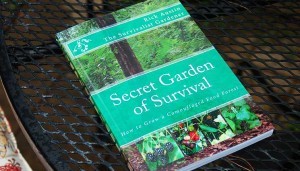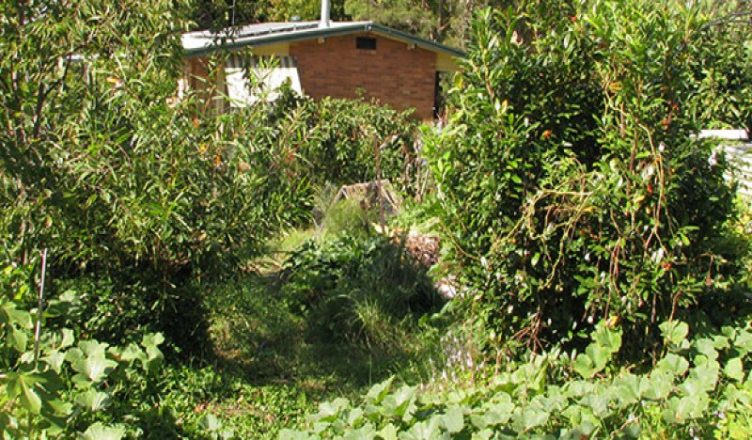If you watch Doomsday Preppers like me you probably saw this Thursdays episode that showcased two Preppers. The difference for me this week was that I have actually heard of two of the preppers on the show. Rick Austin is the author of the Secret Garden of Survival: How to Grow a Camouflaged Food Forest which is an excellent introduction and thought starter on the concepts of Permaculture guilds and how they can be incorporated into the Prepper garden plan.
He frequently speaks at conferences and self-reliance expos. I reviewed his book on the Prepper Journal back in July of 2013. Along with Rick was his wife (and this was news to me) Survivor Jane who has her own survival blog, started the #preppertalk hashtag on Twitter and speaks at Prepper Conferences also.
The show spent the first part of their episode focused on Rick’s camouflaged food forest that he has grown on his secluded property in the Appalachian mountains. I was already familiar with the concepts but seeing his home and surrounding lush permaculture garden was interesting and got me thinking about this subject all over again. If you don’t know what I mean by camouflaged you can watch the video below where Rick shows you some of what he has grown.
What a Secret Garden Looks Like and Why It’s Important with Rick Austin from Beyond Off Grid on Vimeo.
The brilliant aspect of this from the standpoint of preppers is that unlike a garden, the camouflaged food forest requires less maintenance, less water, no chemicals and best of all, doesn’t look like a garden. This could be especially helpful if we have some EMP event like Rick and Jane were prepping for. One fear of a massive EMP strike is that there is no longer any power for long periods of time. With this is the potential for vehicles to no longer work, gas pumps and pretty much any other electronic devices unless they are heavily shielded. If this happens, trucks won’t be rolling to deliver food. Food shortages lead to food riots which lead to people scouring yards looking for food. Gardens will make an easy target in the right season. If your main food source is hidden in what looks like an overgrown patch of plants, you will be more likely to have your secret garden overlooked.
What are Permaculture Guilds?
I found this great article below on the Never Ending Food website that describes the process and concepts nicely. I also recommend getting Rick’s book the Secret Garden of Survival for some great photographs and practical application advice. It is much cheaper on Kindle now. You can also visit Rick’s site and read the first chapter online for free.
Permaculture is based on natural systems like those that we see in forests. In a forest system, there are multiple layers of vegetation growing together in a very diverse setting. We see many types of trees, shrubs, plants, insects, animals, and various other things all living together in a system that continually strengthens itself. All of these components of a natural ecosystem serve a function (or several functions) that support each other like the strands of a web.
One strand on its own may be weak, but the combination of all the strands together add to the overall strength and usefulness of the web.In order to mimic these natural systems and to provide for human needs (i.e. food, building supplies, fuel, fibers, etc.) we must learn to identify and work with the various functions of our natural resources. This is where the concept of the “Permaculture Guild” comes from. A guild is usually defined as an association of people working toward a common goal.
In Permaculture, a guild is a grouping a plants, animals, insects, and other natural components that also work together to help ensure their survival. Instead of planting gardens, Permaculture teaches us how to “build guilds”. Instead of teaching about specific plants, we teach about the plant’s functions. This is why Permaculture can work throughout the whole world. It is a guide for design rather than a “how-to” type of agriculture. (For more information on Permaculture Design, click here.)A good Permaculture guild generally has seven components:
Food for us
When building a guild we need to think about maximizing the health and nutritional benefits that we will be getting from our systems. In order to eat a diversity of foods we need to plant a diversity of foods. In Malawi this should be based on our 6 food groups. This means including fruits, vegetables, staples, legumes & nuts, fats, and even animals. With good planning, we should be able to receive foods from all of the 6 food groups throughout the entire year.
Food for the soil
All plants need nutrients to grow, just like we do. One of the main nutrients that plants use for growth is call nitrogen. An easy way to get nitrogen into the soil is by planting legumes (i.e. beans, peas, groundnuts, leguminous trees, etc). All legumes are considered “nitrogen-fixers” and are able to take nitrogen from the air and convert it to a usable form in the soil. Using legumes actually helps to ”feed” the plants that they are growing near. The leaves and other organic matter from legumes may also be added to compost to increase the nitrogen content. Any organic matter that is added back to the soil will eventually help to act as food for the soil This includes: leaves, kitchen scraps, market resources, decaying matter, compost, compost tea, mulch, manure, etc.
Diggers/Miners
Deep rooted plants, such as trees, will reach deep into the earth’s soil (like a miner) and bring minerals up to the surface. These deep rooted plants also act as diggers to break open the soil, make it soft, and allow for air & water to be easily absorbed. Some diggers also take the form of root crops that can be used as staple foods. Examples of diggers include: cassava, sweet potatoes, yams, Irish potatoes, trees and other deep rooted plants, etc. Diggers can even be insects and animals that burrow through the soil such as: ants, termites, worms, beetles, mice, etc.
Groundcover
These protect the soil from the sun, help to hold moisture, and help to keep “weeds” (good plants in the wrong place) down. There are many types of groundcovers available in Malawi. These include: sweet potato vines, pumpkin, cucumbers (minkaka, zinkhananga, fwifwi, etc), and anything else that will vine or spread across the soil. Mulch is also a form of groundcover.
Climbers
Climbers help to maximize food production, especially in areas where land resources may be scarce or limited. In most  forest sytems you will generally see examples of climbers, because nature uses all of its layers to their fullest potential. Examples of climbers that you can use in Malawi include: beans, passion fruit (magalagadeya), loofa (chinkupule), air potatoes, cucumbers (zipwete, minkhaka), etc.
forest sytems you will generally see examples of climbers, because nature uses all of its layers to their fullest potential. Examples of climbers that you can use in Malawi include: beans, passion fruit (magalagadeya), loofa (chinkupule), air potatoes, cucumbers (zipwete, minkhaka), etc.
Supporters
These are stronger items that support the climbers and make the most of our space. Supporters can be living things like trees, bushes, stalks such as a maize or sunflower, or they can be non-living things like houses, bathing areas, outdoor toilets, walls, fences, etc. The main thing to be careful of is choosing the right supporter for the right climber. Some climbers are very aggressive and can bring down a fence, or take over a tree. If you put a passion fruit vine into a mango tree, you may not end up with any mangoes. This is where thinking ahead and planning become very important.
Protectors
Any thing that helps to protect your guild is a protector. In terms of protecting your guild from damaging insects, strong smelling plants can be very useful. Things like onions, chives, spices, lemon grass, and pungent flowers can help to repel insects and even confuse them making it difficult for them to find their food. Natural predators can also be very helpful in controling the insect problems in a guild. Beneficial animals and insects such as frogs, birds, lizards, praying mantis, ladybugs, etc should be attracted to the garden with various types of habitat and plants that they prefer. You can even protect from larger animals like goats and people by using things with thorns or sharp ends. Some living fences that we have seen are even more effective than the razor wire that many people put along their fences.
Downloads
Click on the link(s) below to download
Permaculture Guild Handout
PDF of a Guild handout that we use for teaching. Feel free to reproduce it, use it for teaching, and share it with others. That is another Permaculture principle – Observe, learn, and share!
source : Pat Henry





